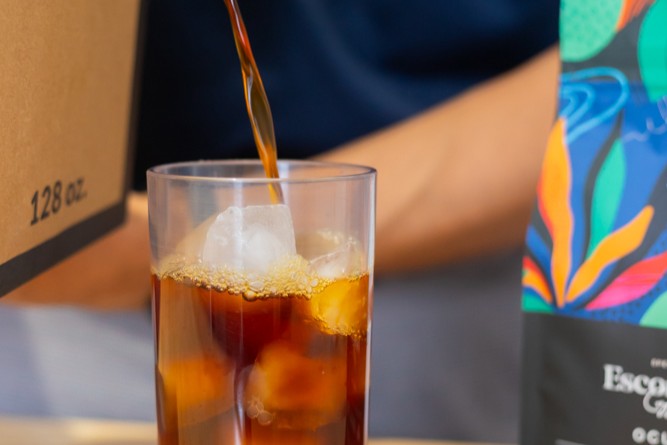
Cold Brew Uncovered: History, Science & Flavor of the Smooth Extraction
Share
Welcome to the first in our series exploring coffee extraction methods, starting here with Cold Brew. Unlike traditional hot brews, cold brew relies on long steeping times at cool temperatures to extract flavor. Today we’ll explore its history, extraction principles, equipment, sensory profile, and more. For business clients, don’t forget we offer Escondido Cold Brew made from El Salvador Oculto, crafted to deliver rich chocolate, caramel, and brown sugar notes consistently.
A Brief History of Cold Brew
Cold extraction traces back to the 1600s, when Dutch traders aboard ships brewed "Dutch coffee" in cold water for safety reasons and longevity during long voyages. This method reached Japan, giving rise to the Kyoto-style cold drip, a refined slow-drip technique in glass towers.
In the 1960s, chemical engineer Todd Simpson created the Toddy® Cold Brew System, making cold brew more accessible commercially. Since then, cold brew has exploded in popularity—with US sales growing by 580% between 2011 and 2016.
How Cold Brew Extraction Works (and Why It Matters)
Extraction occurs when water interacts with coffee grounds over time. In cold brew:
- Temperature: Room temperature or colder (~4–25 °C).
-
Time: Typically, 12–24 hours, sometimes up to a day
Studies suggest that most flavor compounds extract within hours, meaning extreme steep times may not be necessary.
Cold extraction favors low-energy, prolonged contact between water and coffee, reducing bitterness and acidity while preserving body and sweetness.
Extraction degree of around 70% at 15 °C for 2 h (80 g/L) is recommended to preserve flavor and limit microbial risks.
Caffeine Content: Does Cold Brew Pack a Punch?
Caffeine extracts slower in cold brew compared to hot methods, but over prolonged contact, it reaches significant levels. According to research by Fuller and Rao, caffeine extraction plateaus within hours, and brew strength determines content more than method.
Studies demonstrate that, gram-for-gram, cold brew concentrate can exceed the caffeine of drip coffee, especially when fermented in high coffee-to-water ratios.
Agitation during brewing (e.g., stirring) can increase caffeine extraction by up to 20%, offering a way to adjust potency.
Equipment & Budget for Cold Brew
Cold brew is simple to begin:
- DIY methods: Use a French press, mason jar, or Toddy® system (budget-friendly).
- Commercial equipment: Cold brew towers or refrigerated dispensing units for businesses.
Materials are generally affordable, large batches brew overnight, making it cost-effective for cafés and offices.
Grind Size, Roast Level & Water Factors
- Grind Size: Coarse grind recommended to avoid over-extraction and ease filtration.
-
Roast Level: Medium roasts yield sweetness; overly dark roasts may yield less flavor clarity and higher bitter notes.
- Water: Room temperature to cold; warmer temps can speed extraction but risk microbial activity.
Sensory & Taste Profile
Cold brew typically features:
- Smooth sweetness
- Low acidity
- Full mouthfeel
- Flavor descriptors: chocolate, caramel, nutty, as documented by sensory research.
Due to low acidity, it’s loved by those with digestive sensitivities.
Safety & Shelf-Life Considerations
Cold brew requires strong food safety practices:
- Made at low temps without pasteurization, risking bacterial growth.
- Should be consumed fresh; refrigeration and minimal storage duration ("as fresh as possible") are essential
Shelf-life is estimated at up to two weeks refrigerated, though flavors degrade over time.
Cold Brew vs. Iced Coffee
Often confused, these are different:
- Cold Brew: Steeped in cold water for extended time (12–24h).
-
Iced Coffee: Hot brewed, then poured over ice
Cold brew offers smoother, fuller body; iced coffee has brighter acidity and lighter mouthfeel.
Cold Brew in Practice: What's Escondido Offering?
We're excited to offer Escondido Cold Brew tailored for businesses, crafted with El Salvador Oculto single-origin beans:
- Tasting notes: Chocolate, caramel, brown sugar.
- Advantages: Smooth, low-acid, with strong market appeal.
- Packaging: 1-gal or 5-gal. Ready-to-serve for cafés, hotels, and events.

Conclusion
Cold brew is a blend of history, science, and taste, elevated by time, temperature, and terroir. From centuries-old Dutch techniques to today’s specialty offerings, it’s a method rich in complexity and simplicity at once.
Stay tuned, because next week we dive into French Press, another immersive method that offers its own world of flavor, texture, and history.
